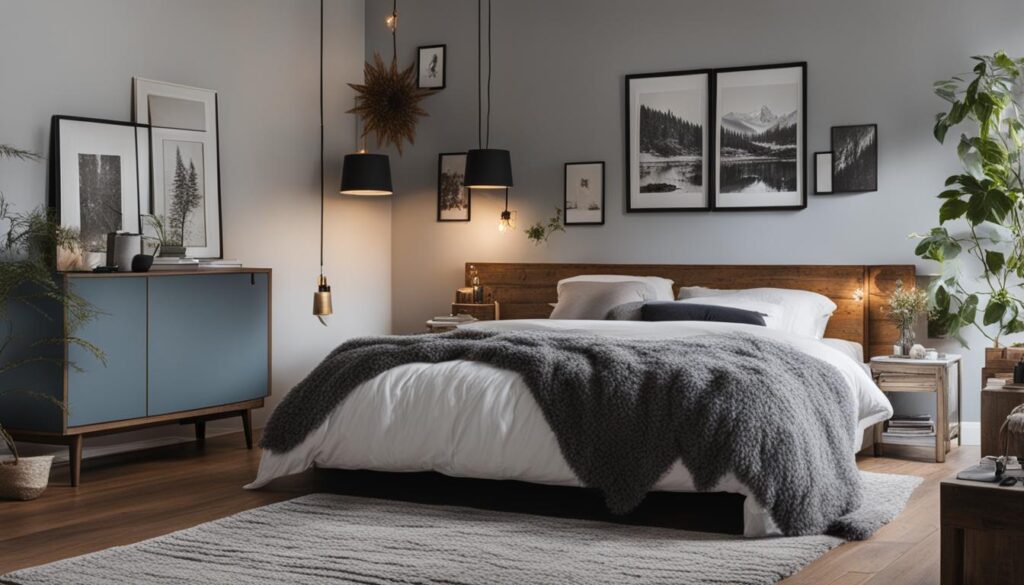Transforming a living room into a bedroom can be a practical and efficient way to maximize space in your home. With the right furniture and design choices, you can create a cozy and functional sleeping area without sacrificing the functionality of your living room.
In this guide, I will explore various methods and tips for converting your living room into a bedroom, including the use of sofa beds, sleeper sectionals, and multi-purpose furniture. I will also discuss the importance of natural light, light colors, and room dividers in maintaining privacy and creating a visually appealing space.
Table of Contents
Key Takeaways:
- Transforming your living room into a bedroom can help maximize space in small living areas.
- Select furniture such as sofa beds, sleeper sectionals, and multi-purpose pieces for dual functionality.
- Consider using room dividers, light colors, and cozy accents to create privacy and visual appeal.
- Maximize natural light to make the room feel more spacious and inviting.
- Add personal touches like rugs, curtains, and pillows to enhance the visual appeal of the space.
Choosing the Right Furniture
One of the most important aspects of transforming a living room into a bedroom is selecting the right furniture. The furniture you choose should provide comfort during the day and convert into a bed at night, maximizing the functionality of the space. Here are some options to consider:
Sofa Bed
A sofa bed is a versatile piece of furniture that combines a sofa with a bed. During the day, it provides comfortable seating, and at night, it easily transforms into a bed. Sofa beds come in various sizes and styles, allowing you to choose one that suits your space and aesthetic preferences.
Sleeper Sectional
A sleeper sectional is a great option for larger living rooms. It offers ample seating during the day and can be converted into a spacious bed at night. Sleeper sectionals come in a range of designs, allowing you to find one that fits seamlessly into your living room decor.
Chair Bed
If you have limited space in your living room, a chair bed can be a practical choice. It functions as a comfortable armchair during the day and can be unfolded into a bed for sleeping. Chair beds are available in various styles and sizes, making it easy to find one that suits your needs.
In addition to these options, there are other furniture pieces that can enhance the functionality of your living room-bedroom. Futons are a space-saving alternative to sofa beds, offering seating during the day and a bed at night. Storage ottomans, storage coffee tables, and storage end tables provide clever storage solutions for bedding and personal items, helping you keep your space organized and clutter-free. Lift-top coffee tables can serve as a desk, making them ideal for those who need a workspace in their living room-bedroom. Finally, daybeds and trundle beds are perfect for small spaces, providing additional sleeping accommodations when needed.
Choosing the right furniture is crucial in creating a comfortable and functional sleeping area within your living room. Consider your space limitations, aesthetic preferences, and storage needs when selecting furniture pieces that will help you make the most of your living room-bedroom transformation.
Creating Privacy and Visual Appeal
When converting a living room into a bedroom, it’s crucial to consider both privacy and visual appeal. By incorporating the right elements, you can transform the space into a cozy and inviting sleeping area. Here are some key factors to consider:
Room Dividers:
Room dividers are an excellent way to create separation and privacy within your living room-bedroom combination. You can choose from various options such as sliding doors, bookshelves, or curtains. These dividers not only provide privacy but also add an aesthetic appeal to the overall design.
Minimalist Design:
A minimalist design approach can help prevent the space from appearing cluttered. It involves using clean lines, simple furniture, and minimal decorative items. This design style not only promotes a sense of calmness and tranquility but also creates an open and visually spacious environment.
Natural Light and Light Colors:
Incorporating natural light into the space is essential for creating a bright and airy atmosphere. Utilize light curtains or blinds that allow sunlight to filter in, making the room feel more spacious. Additionally, choose light colors for the walls, furniture, and decor to further enhance the sense of openness and brightness.
Cozy Rugs, Curtains, and Pillows:
Add warmth and comfort to the sleeping area by incorporating cozy rugs, curtains, and pillows. Choose soft and plush materials that create a cozy ambiance, making the space feel inviting. These elements also add texture and visual interest to the overall design, enhancing the visual appeal of the converted bedroom.
By considering these factors, you can create a living room-bedroom combination that offers both privacy and visual appeal. Whether you’re transforming the space for guests or maximizing limited square footage, these tips will help you create a functional and aesthetically pleasing sleeping area within your living room.
Conclusion
Converting small living spaces into multi-functional areas is a popular trend, and transforming a living room into a bedroom is an excellent space-saving solution. By implementing clever ideas and incorporating practical design choices, you can achieve a successful living room makeover that maximizes both functionality and comfort.
When dealing with small living spaces, it is crucial to consider multi-functional furniture options. Sofa beds, sleeper sectionals, and chair beds provide the perfect balance between seating during the day and a cozy bed at night. Additionally, storage ottomans, coffee tables, and end tables offer clever storage solutions for bedding and personal items, ensuring that everything has its place.
Creating a visually appealing and private sleeping area within a living room requires some thoughtful design choices. Utilizing room dividers, such as sliding doors, bookshelves, or curtains, can effectively separate the space and provide the necessary privacy. To make the room feel more spacious, incorporating natural light and using light colors like yellow, light blue, and white is essential. Adding cozy rugs, curtains, and pillows will create a warm and inviting atmosphere, perfect for a restful night’s sleep.
In conclusion, with the right furniture selection and strategic design choices, transforming a living room into a bedroom can result in a functional and visually appealing space. Embracing the concept of multi-functional living spaces allows you to maximize every inch of your small living area. So, if you’re looking for space-saving bedroom ideas, consider converting your living room into a cozy sleeping haven while maintaining its functionality as a living area.
FAQ
What are some furniture options for transforming a living room into a bedroom?
Some furniture options include sofa beds, sleeper sectionals, chair beds, futons, storage ottomans, storage coffee tables, storage end tables, lift-top coffee tables, daybeds, and trundle beds.
How can I create privacy and visual appeal in a living room turned bedroom?
You can create privacy and visual appeal by using room dividers like sliding doors, bookshelves, or curtains. A minimalist design approach, maximizing natural light, incorporating light colors, and adding cozy rugs, curtains, and pillows can also enhance the visual appeal of the space.
Is converting a living room into a bedroom a practical solution for small living spaces?
Yes, converting a living room into a bedroom can be a practical solution for maximizing space in small living areas.


